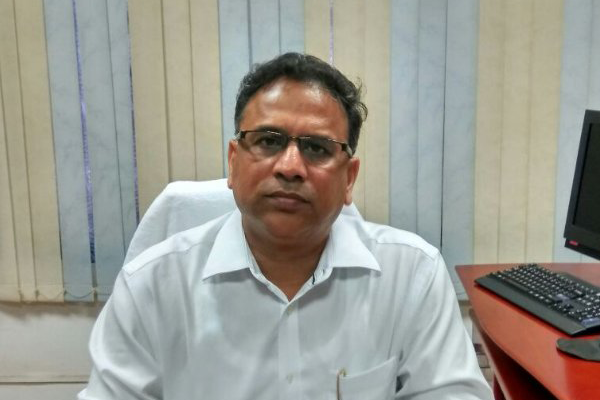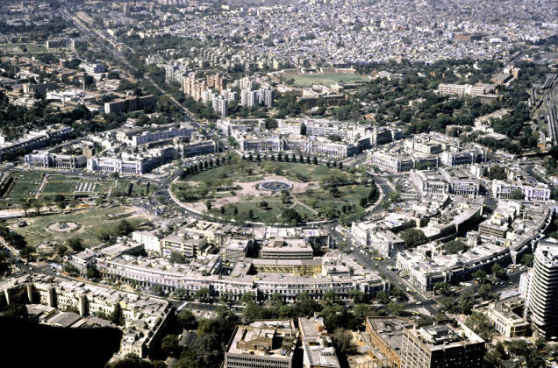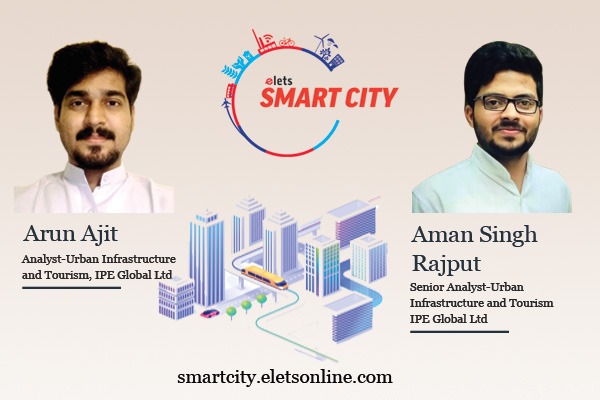
Abstract
The remarkable surge in religious tourism and subsequent urban development in heritage cities throughout India makes it imperative to investigate the significance of preserving and promoting the unique identity of these cities. Effective urban planning and development strategies are key to achieving this goal and have been reflected in recent urban reforms implemented by the Indian government, such as HRIDAY, PRASAD Scheme, Swadesh Darshan scheme, and others. Additionally, centrally sponsored schemes and programs like the Smart Cities Mission and CITIIS are working in close conjunction with these initiatives.
This study examines the case of Mahakaal Mahalok, a landmark project under the Ujjain Smart City initiative in India, which aimed to champion the local identity of Ujjain city. Drawing inspiration from Kevin Lynch’s “5 elements of the city,” the research explores the city’s character and its expression through the Mahakaal Mahalok project. It investigates the methodology adopted for the project, with a specific emphasis on community engagement, and analyses the outcomes through desk review. The findings of this research aim to provide insights into the importance of safeguarding the distinctive local identity of cities amidst cultural diversity and national development initiatives.
Introduction
‘Identity’ implies the distinguishing characteristics and qualities that define how we perceive people, groups, and entities1. This same notion holds true for spaces and cities as it defines their ‘imageability’ which is derived from the uniqueness of its physical, social, cultural, and historical elements. It also includes a supporting environment through which people interact and comprehend them. This interaction and coherence of city elements are critical as “Nothing is experienced by itself”2 and influences the way people live, work, and socialise.
Figure 1: Pathways during off-peak and peak seasons

A city’s identity is an essential aspect of urban planning and design, as it promotes strategies and policies to (i) Establish a sense of place and foster an emotional attachment to the city; (ii) Develop cities as tourist centres to enhance local revenues and (iii) Frame future development guidelines ensuring new development & public spaces are in harmony with the city’s existing character and personality3.
India’s varied cultural and architectural heritage which is identifiable through its designs, landmarks, people, and customs, accounts for the vital need to safeguard the distinctive local identity of each city. Drawing from this, the paper reflects upon the landmark project ‘Mahakaal Mahalok’ development and its process of ‘championing local identity’. The paper delves into investigating the city’s character through the lens of ‘5 elements of the city’ by Kevin Lynch. The project was developed by IPE Global Limited for the Ujjain Smart City Limited under the Smart Cities Mission. The paper focuses upon the methodology adopted to develop the project, concentrating on the people’s involvement and concluding its outcomes.
The study delineates key elements and characteristics that contribute to the image of Ujjain, while also addressing the challenges faced by this ancient city in the context of urbanisation and its status as a religious tourism destination. It will elucidate the methodological approach employed to channel the local identity into the interventions undertaken. Furthermore, the study will examine the outcomes of the project and delve into the positive impacts experienced as a result of these endeavours.
Ujjain and Its Identity
Ujjain is a historic city located in the state of Madhya Pradesh. It has a rich cultural and religious heritage dating back to ancient times. The city is situated on the banks of the sacred river Kshipra and is one of the seven holiest cities in Hinduism4 where devotees seek to attain Moksha. Ujjain is well known for its numerous temples, which annually draw a sizable number of pilgrims and tourists. The Mahakaleshwar Temple, devoted to Lord Shiva and thought to be one of India’s twelve Jyotirlingas, is one of the most renowned temples in Ujjain, making it a major tourist attraction in the city. Apart from the ancient architecture, Ujjain is one of the four holy cities where the famous Kumbh Mela is held every 12 years, attracting approximately 5 lakh devotees4 daily from all over India. During these festive occasions of Kumbh Mela, Nagpanchmi and Mahashivratri the city is transformed into a vibrant hub of spiritual and cultural activity. Under the Smart Cities Mission, the Mahakaal Area was identified as the initial node for the Area Based Development to retrofit and develop it as a ‘Religious and Cultural Hub’ to best revitalise the religious tourism experience.
The elements of identity:
Paths: The layout of the city is characterised by processional streets, which not only shape its physical form but also offer important views and routes to the city’s focal points, namely the Mahakaal Temple and the Kshipra River. Additionally, during festive occasions, these streets serve as recreational spaces and overflow with pilgrims and related street vendors.
Figure 2: Various Paths, Nodes, Edges and Landmarks around Ujjain City
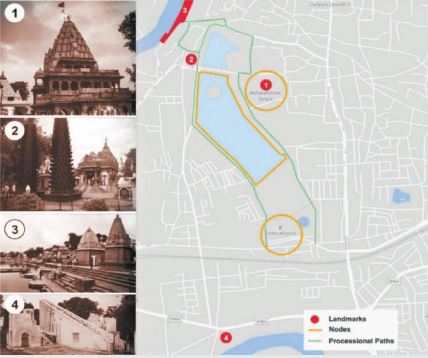
Edges: Strong edges are present around Ujjain which define the form and layout of the city: (i) River edges (The Kshipra River) run along the northern edge of Ujjain, flaked with ghats (Ramghat) serving as important pilgrimage sites for devotees. (ii) Green edges that surround the city, including the forests, the agricultural fields and waterbodies which provide a natural buffer and contribute to the city’s scenic beauty.
Landmarks: The city is imbued with the glory of ancient architecture from the intricacies of temple shikaras to recreation ghats to scientific observatories. The key landmarks that position themselves around Ujjain are:
Ujjain faces several challenges in managing the inflow of pilgrims and tourists, which has been on a constant rise. One of the primary challenges is accommodating the ever-increasing floating population of pilgrims and tourists in and around the Mahakal temple precincts. In addition, tourists and pilgrims find it difficult to locate public spaces/recreational areas to spend some time around the Mahakal temple during their wait for darshans. The lack of services and facilities available to the tourists or visitors is also a significant challenge that hampers the city’s economy, as the lesser time a tourist spends in the city, the lesser the economic benefits for the city. Another challenge is the lack of access from transport hubs to the temple precincts, which makes it difficult for visitors to reach their destinations.
2.3. Need of the Project
Figure 3: City wide stakeholder consultations and Focus Group Discussions

The urgency to address crucial issues satisfying both the resident population and the multitude of pilgrims flocking to the city’s spiritual centre cannot be overstated, all while preserving the significant identity of Ujjain. The residents and pilgrims fervently called for transformative actions in three key areas: (1) Decongesting the Core: for it currently lacks essential open spaces and perpetually battles for spaces amidst the overwhelming presence of pilgrims, vehicles, street vendors, and festive processions, (2) Enhancing the visibility: diminished by encroachment the important ‘nodes’ of the area including the iconic ‘Rudrasagar’ Lake and other cherished landmarks, demanded immediate revitalization to regain their rightful prominence and visibility and (3) Safeguarding the ancient identity: embodied by its magnificent murals, statues, and heritage structures, needs safeguarding through restoration and conservation. It is required to integrate the iconic elements with the new developments to establish a robust connection between the past and present ensuring the city’s enduring legacy.
3. Approach Adopted
The Mahakaal Mahalok project (Phase-1) addressed these challenges through a citizen-centric approach to revitalise and redevelop the area in accordance with the aspirations and needs of the local community and stakeholders. The focus was on improving the infrastructure, creating more open/public spaces, and providing better services and facilities for the tourists and visitors. The approach adopted aimed to preserve and honour the city’s cultural heritage and identity. Considering its unique architecture, culture, and sentiments, as well as the past experiences of its residents the project weaved in a deep-rooted connection for new development with the image of Ujjain’s glory.
The consultative approach was followed involving extensive stakeholder consultations at the city-wide level. The project development team engaged with Ujjain Development Authorities, and Shree Mahakaleshwar Temple trustees. These consultations aimed to identify key areas and ‘nodes’ for revitalization and redevelopment. Among these, the Area Based Development (ABD) area, comprising the religious and cultural hub, emerged as the primary focus of development in Phase-1.
Also Read | Building Capacity of Urban Local Bodies
In addition to the development authorities, comprehensive Focus Group Discussions were conducted with various local businesses, tourists, pujari purohit samiti, public representatives, various government departments, and residents. These discussions served to effectively communicate the development strategies and enhance public understanding of the development process. They also facilitated the expansion of the development area, encompassing the identification of strategic land for the construction of pedestrian roads, public spaces, and necessary infrastructure.
4. Project interventions creating nexuses for local identity
The development of the Shri Mahakaleshwar temple precinct through a consultation approach resulted in the creation of a spacious public area on the western side of the temple, providing pilgrims and tourists with a state-of-theart experience with the key components of this development being.
Figure 4: Project Intervention Map
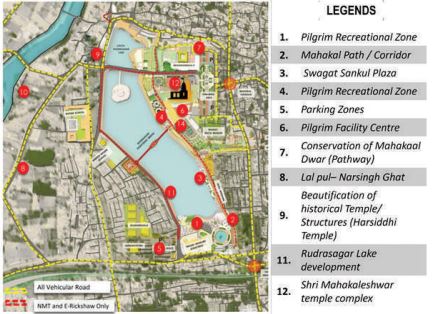
The redevelopment of the Shri Mahakaleshwar temple precinct focused on creating a well-designed and visitorfriendly environment. It offers enhanced amenities, improved pathways, and spaces that catered to the diverse needs of pilgrims and tourists embodying the strong cultural identity of Ujjain in every form.
Figure 5: Development of Public open spaces around the Western node of
Trivani Museum

Decongesting the Core: Strategies implemented to restrict vehicular movement and transform the Mahakaal corridor into a pedestrian-friendly zone. These were accompanied by the development of necessary infrastructure and the alignment of pilgrim facilities and local businesses along this corridor. The project holistically addressed the diverse challenges by focusing on the development of the core as a spacious open area. This expansion aimed to accommodate the large influx of pilgrims, particularly during seasonal festivals. The existing Triveni Museum, serving as a well-established node, played a crucial role in facilitating the integration of these new developments. This not only enhanced the convenience and safety of pilgrims but also created opportunities for local businesses to thrive in the bustling core area.
Visibility and Access: To enhance the local identity significant measures were taken to transform the nodes and the processional pathways leading to Mahakaal into fully pedestrian zones. Vehicular restrictions were implemented to ensure the exclusivity of these paths for pedestrians.
Figure 6: Stambhas and Murals along the Mahakal Corridor
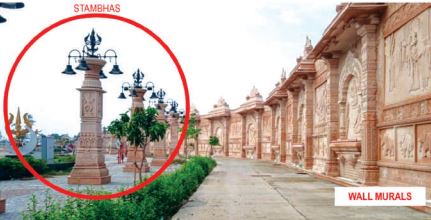
One of the notable interventions in this regard is the Mahakaal Corridor, which best reflects local identity embellished across 108 Stambhas depicting the Anand Tandav Swaroop (dance form) of Lord Shiva. These pillars serve as a visual representation of the divine dance and add a distinct religious and cultural element to the pathway. Another remarkable feature is the mural and sculpture wall that runs along the corridor which draws inspiration from various stories of Shiv Puran, including the Act of Universe Creation, Birth of Ganesha, Story of Sati and Daksha, and Creation of Veerbhadra, among others. This strong edge spans a length of 365 metres and reaches a height of 7.65 metres meticulously preserving the aesthetic identity of ancient Ujjain.
Local identity: Catering to the needs of devotees and pilgrims, the development of pilgrim infrastructure and facilitation centres was of paramount importance. As part of the Phase-1 of the Mahakaal Mahalok project, several amenities have been established, taking inspiration from the architectural style of ancient Ujjain. Few notable facilities are the Triveni Mandapam and Mansarovar Facility Centre which are strongly influenced by ancient temple architecture. The Triveni Mandapam and Mansarovar facility centre serves as a shaded area where people can find respite and rest and wait for temple darshans respectively.
It is designed to harmonise with the traditional aesthetics of Ujjain. Additionally, the plaza area adjoining these facilities feature open-air theatres opening towards the Rudrasagar Lake and resemble the essence of a Ghat. These versatile spaces can be utilised for various activities such as yoga sessions, artistic performances, and cultural events, further enhancing the experience for pilgrims and visitors.
Figure 7: Structures influenced by Ujjain’s ancient identity. Above: Triveni Mandapam; below Mansarovar Facilitation Centre
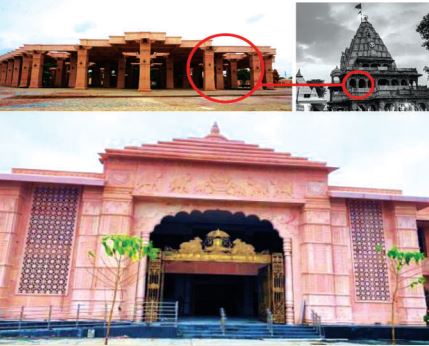
Local identity in the details: Irrespective of their scale, the designs and interventions implemented in the project consistently reflect and embody the authentic identity of Ujjain. This commitment to maintaining the city’s roots is evident in the meticulous attention to detail observed in various spaces, ranging from vendor zones to the designs adorning e-rickshaws. Planned and developed vendor zones encapsulate the essence of Ujjain’s heritage. The designs incorporated on the e-rickshaws draw inspiration from traditional Ujjain prints, including the art form of Batik Printing. These intricate patterns and motifs not only serve as visual representations of the city’s cultural heritage but also create a sense of nostalgia, reminiscent of old Ujjain.
Figure 8: Identity in the details. Above: Vendor Zones; Below: E-rickshaw
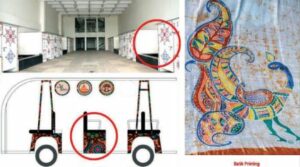
By infusing these elements into the project, a cohesive and authentic atmosphere is fostered throughout the city. This attention to detail ensures that Ujjain’s unique identity is honoured and preserved, creating a truly immersive and culturally enriching experience for both residents and visitors alike.
5. Impacts
The observed impacts of the project through desk research and secondary data available, has been significant and far-reaching. The number of pilgrims visiting the temple premise has increased three to four times from 25 thousand to 1 Lakh per day on off-seasons and 1.5 to 2 lakhs on weekends, showcasing a substantial growth in religious tourism. (As referenced in Figure-9 C). Based on the newspaper reports post project implementation the revenues have increased threefold from September 2022 to April 2023. (As referenced in Figure-9 A). The occupancy of hotels has gone up to 95 percent throughout most days of the month. (As referenced in Figure-9 C). As per the Madhya Pradesh Tourism Board, the impact on the hospitality industry has been remarkable. A sharp increase in the number of home stays in Ujjain with 100+ homestay registered post project implementation. These establishments have boosted local economies and their numbers are on a sharp rise. (As referenced in Figure-9 C)
Also Read | Architecture and collective identity
These remarkable impacts demonstrate the success and positive outcomes of the project, resulting in increased pilgrimage, greater economic activity, and improved tourism infrastructure in the region.
6. Conclusions
The development of the Mahakaal Mahalok project (Phase-1) in Ujjain exemplifies the significance of championing local identity in urban planning and design. The project’s approach and methodology revolved around understanding and preserving the unique elements that define Ujjain’s cultural heritage and image. Engaging with the stakeholders and incorporating their aspirations and needs, the project successfully revitalised and redeveloped the area, catering to both the local community and the growing number of pilgrims and tourists. As coined by Prime Minister Narendra Modi through this project “India is renovating and restoring its glory.”
By championing local identity, the Mahakaal Mahalok project not only improved the infrastructure and services available to residents and tourists but also strengthened the emotional attachment to the city. The project’s success serves as a testament to the importance of preserving and promoting the distinctive identity of each city, contributing to its sense of place, economic growth, and cultural sustainability. The approach employed in this project demonstrates substantial potential for broader applications in diverse urban development initiatives throughout India. It serves as a pioneering model for effectively harmonising cultural and local identity with contemporary development, paving the way for seamless integration and mutual enrichment.
Figure 9: Newspaper Reports of project impacts

7. Acknowledgement
We would like to express our sincere gratitude to Ujjain Smart City Limited and its officials and IPE Global for sharing valuable information for providing us with necessary project details and information and framing the research paper. Your willingness to provide us with access to this information is greatly appreciated and has significantly contributed to the success of our study. Particularly, we would like to extend our sincere appreciations to Mr. Anil Kumar Bansal (Senior Director, Urban Infrastructure and Tourism, IPE Global Ltd), Mr. Sanjay Shakya (Team Leader), Mr. Ravi Shankar, Ms. Surabhi Kureel, Mr. Prince Aggarwal and Mr. Amit Harishankar Gupta for their continuous support throughout the research process. Their valuable insights, constructive feedback, and encouragement have been instrumental in shaping the final work.
8. Disclaimer
This research work is entirely that of the author/co-author and does not carry the views of the organisations mentioned herein.
Authors: Arun Ajit, Analyst-Urban Infrastructure and Tourism, IPE Global Ltd, Aman Singh Rajput – Senior Analyst, Urban Infrastructure and Tourism IPE Global Ltd















